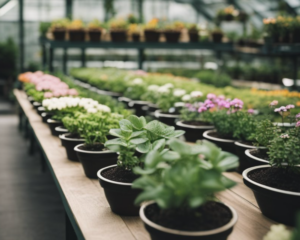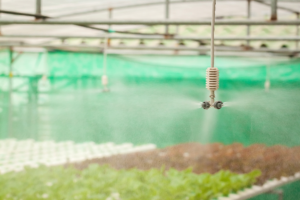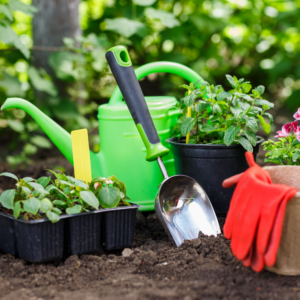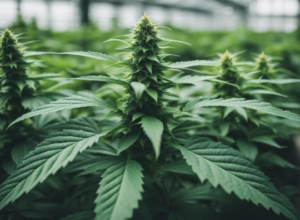Lean-to greenhouses are a compact and economical way to grow plants throughout the year. This type of greenhouse is attached to an existing structure, such as a house or a garage. The shared wall provides insulation, making the greenhouse easier and less expensive to heat. Gardeners like growing in this type of greenhouse. They can grow plants that might not survive a colder season, elongating the gardening season.
The lean-to’s minimal footprint and ability to make use of an existing wall also appeal to urban and suburban gardeners who are short on space. They need less material and (if constructed against your home) can be easier to build than a freestanding greenhouse. For the DIY enthusiast, the lean-to greenhouse offers many opportunities to personalize its design and structure, whether as a seed-starting station, a grow-your-own-exotic-flowers portfolio or a winter enclosure for vegetables.
The orientation and location require careful consideration; the lean-to greenhouse should ideally face the sunniest direction, which is south in the Northern Hemisphere. This allows the plants to bask in the sunlight, which is essential for their growth. At the same time gardeners should make sure that the greenhouse does not interfere with drainage and structure of the building it leans on. In conclusion, lean-to greenhouse is a great way for gardeners to make use of building corners and make the most out of the sunlight.
Exploring the Advantages and Disadvantages of a Lean-To Greenhouse
| Advantages | Disadvantages |
|---|---|
| Space Efficiency | Limited Sunlight Exposure |
| Utilizes limited garden space effectively by attaching to existing structures. | Receives less sunlight due to being attached to a building. |
| Accessibility | Restricted Size |
| Easy access linked to a home, allowing for convenient gardening. | Generally offers less space than freestanding greenhouses. |
| Cost-Effective | Building Damage Risks |
| Less expensive construction and heating costs by using an existing wall. | Potential for water damage or mold on the shared building wall. |
| Microclimate Control | Permit and Regulations |
| Easier temperature regulation due to heat from the attached building. | May require more stringent building permits and regulations. |
| Enhanced Aesthetics | Resale Value Impact |
| Can improve the appearance and value of a property. | Potential negative impact on resale value if not universally appealing |
1. Design and Location
The success of a lean-to greenhouse largely hinges on its design and location. A well-placed greenhouse maximizes sun exposure and moderates temperature effectively.
Choosing the Right Location for Sun Exposure
When selecting a location for a lean-to greenhouse, one must consider the path of the sun. The ideal position is on a south-facing wall to capture maximum sunlight throughout the year, especially during the winter months when the sun is lower in the sky.
- Orientation:
- South-facing for Northern Hemisphere locations
- North-facing for Southern Hemisphere locations
- Obstructions:
- Avoid trees, buildings, or other structures that may cast shadows.
- Considerations:
- Proximity to utilities (water, electricity)
- Protection from strong winds
Designing for Optimal Light and Temperature
The design of a lean-to greenhouse should prioritize light intake and stable temperature control. Materials and structure are important factors here.
Materials:
- Glazing: Polycarbonate or glass to allow ample light transmission.
- Frame: Aluminum or wood for sturdy support.
Structural Elements:
- Roof Angle: Around 30 degrees to reduce glare and optimize light absorption.
- Insulation: Double-glazing or thermal blankets to lessen temperature fluctuations.
- Ventilation: Install roof vents and side vents to manage humidity and temperature inside the greenhouse.
Emphasizing these design considerations will ensure that the greenhouse provides the right conditions for plant growth year-round.
2. Structure and Materials
When constructing a lean-to greenhouse, choosing the right materials for the frame and walls is crucial for durability and climate control. Different glazing materials can significantly impact the light transmission and insulation properties of the greenhouse.
Selecting Materials for Your Greenhouse Frame and Walls
The frame of a lean-to greenhouse serves as the skeleton, providing structural support.
- Materials commonly used for greenhouse frames include:
- Aluminum: Lightweight, durable, and resistant to rust.
- Galvanized steel: Strong and can withstand heavy loads, but requires rust prevention treatments.
- Wood: Traditional look and natural insulation but requires regular maintenance to prevent rot.
For the walls, builders often use:
- Twin-wall polycarbonate: It provides good insulation and diffuses light, reducing the risk of plant burn.
- Polyethylene film: A cost-effective option suitable for temporary or seasonal greenhouses.
Each material has distinct properties that affect the greenhouse’s performance and longevity.
Glazing Options: Glass vs Polycarbonate
The choice of glazing greatly affects the greenhouse’s light transmission and insulation.
Glass:
- Pros: Peaks in light transmission; long-lasting if cared for properly.
- Cons: More expensive and fragile; potentially hazardous in the event of breakage.
Polycarbonate:
- Pros: Lightweight and stronger than glass, with better insulation properties.
- Cons: Can discolor over time; less light transmission compared to glass.
The choice between glass and polycarbonate panels will depend on the gardener’s specific needs, climate, and budget.
3. Greenhouse Climate Control
Proper climate control is vital in a lean-to greenhouse to maintain an optimal growing environment. It involves managing ventilation, heating, and cooling to protect plants from extreme temperature fluctuations.
Ventilation for Plant Health and Humidity Regulation
A lean-to greenhouse needs effective ventilation to regulate humidity and prevent plant diseases. Automatic vent openers can be installed, which open and close based on the temperature. Meanwhile, louvre vents can also be added to the sides of the greenhouse for cross-ventilation. This helps in maintaining fresh air flow and suitable humidity levels, especially during the warmer months.
- Types of Vents:
- Roof vents
- Side louvre vents
- Manual or automatic systems
Heating Solutions for Cold Climates
During the winter months, maintaining warmth in a lean-to greenhouse is essential. Insulation materials, such as bubble wrap, can help retain heat. For active heating, options include electric heaters, gas heaters, or passive solar heaters. It’s important to use a thermostat for precise temperature control to ensure that the warmth is evenly distributed and to avoid overheating.
- Heating Options:
- Electric heaters
- Gas heaters
- Solar heaters
Note: The right heating solution depends on the size of the greenhouse and local climate conditions.
Cooling and Shading in Hot Weather
Cooling systems are important to prevent overheating in summer. Shade cloths can reduce light intensity and hence lower temperatures. Additionally, evaporative cooling systems can be highly effective for temperature control.
- Cooling Methods:
- Shade cloths
- Evaporative coolers
- Reflective coatings
Regular monitoring of temperatures and adjusting the cooling and shading devices accordingly will ensure a stable environment for plant growth in hot weather conditions.
4. Maximizing Growing Space
When managing a lean-to greenhouse, smart arrangement strategies are crucial. Thoughtful shelving and maximizing vertical space can turn a limited area into a productive garden.
Effective Shelving and Plant Arrangement
The right shelving is a cornerstone of space maximization in greenhouses. Shelving should be chosen with both durability and functionality in mind.
- Shelving Material: Metal or plastic are preferred for their longevity and ease of cleaning.
Greenhouse kits often include shelving options tailored for the specific greenhouse design. For a walk-in greenhouse, one should consider shelves that provide adequate space for plant growth while allowing for easy access for maintenance. It’s crucial to maintain good airflow and light distribution to the plants.
- Arrangement: Taller plants should be placed on the lower shelves to prevent shading smaller plants. Similarly, staggered levels can allow for maximum light exposure.
Utilizing Vertical Space Efficiently
Vertical space is often underutilized in both small greenhouses and larger installations. There are various ways to make the most of this area.
- Hanging Baskets: Ideal for trailing or vine plants.
- Stackable Planters: Serve as a means to grow vertically without the need for additional shelving.
- Trellises: Can be used to support climbing plants, increasing the yield per square foot.
Vertical solutions not only increase planting space but also can contribute to the overall health of the greenhouse by improving air circulation around the plants. Careful consideration of plant height and the potential shadowing of lower plants should guide their placement.
5. Greenhouse Add-Ons
Enhancing your lean-to greenhouse with specific add-ons can significantly improve functionality and ease of gardening. From ergonomic tools to automated climate control, every addition plays a role in optimizing plant growth.
Accessorizing Your Lean-To Greenhouse with Tools and Gadgets
Doors and Windows: Upgrading the greenhouse doors and windows can have a substantial impact on access and ventilation. Consider adding sliding doors for easy entry and exit, or installing automatic window openers which respond to temperature changes, ensuring optimal airflow without manual intervention.
Lighting: Plants thrive with proper light. Introduce grow lights if your natural lighting is insufficient. One can choose LEDs for energy efficiency or HID lights for more intensity. Always ensure your lighting system is waterproof and safe for greenhouse use.
Pest Control: Safeguard your plants with integrated pest control solutions. This could include insect screens for windows and doors, or organic sprays. Ensure they are non-toxic to avoid harming your plants or beneficial insects.
Tools: Equip your greenhouse with essential tools such as pruners, trowels, and watering cans. Opt for tools with ergonomic designs to reduce strain during lengthy gardening sessions.
Adjustable Roof Vent: Install an adjustable roof vent for regulating temperature and humidity. An automated vent which reacts to weather conditions can be a smart investment, ensuring your plants remain in a controlled environment at all times.
Frequently Asked Questions
In this section, readers find answers to common queries about constructing and choosing lean-to greenhouses, from DIY tips to material suggestions and cost expectations.
How can I build a DIY lean-to greenhouse?
To build a DIY lean-to greenhouse, one typically starts by selecting a suitable south-facing wall and measuring the desired space. Next, they frame the structure using weather-resistant materials like treated wood or aluminum. The cover can be made of polycarbonate panels or glass, ensuring that proper ventilation and insulation are incorporated into the design.
Where can I find plans for constructing a lean-to greenhouse?
Plans for constructing a lean-to greenhouse can be sourced from several places, including online gardening forums, greenhouse supply websites, and home improvement stores. Frequently, these plans come with detailed instructions and a list of necessary materials.
What materials are best for a sturdy lean-to greenhouse structure?
For a sturdy lean-to greenhouse, materials like aluminum or galvanized steel for the frame, and polycarbonate panels or tempered glass for the walls and roof are often recommended. These provide durability and long-term resistance to weather conditions.
How much typically does a polycarbonate lean-to greenhouse kit cost?
A polycarbonate lean-to greenhouse kit can range in cost from a few hundred dollars for a basic model to several thousand for a larger, more feature-rich kit. The price can vary based on size, materials, and included accessories.
What are the top recommendations for lean-to greenhouse kits?
Top recommendations for lean-to greenhouse kits include brands like Palram, Rion, and Juliana, known for their quality materials and ease of assembly. Gardeners often choose kits from these manufacturers for their reliability and range of sizes and features.
What are the considerations for choosing glass in a lean-to greenhouse?
Considerations for choosing glass for a lean-to greenhouse include the type of glass. Tempered or safety glass is often preferred. Additionally, the glass should provide appropriate insulation and resistance to impact. Also, make sure that the greenhouse frame can support the weight of the glass.






